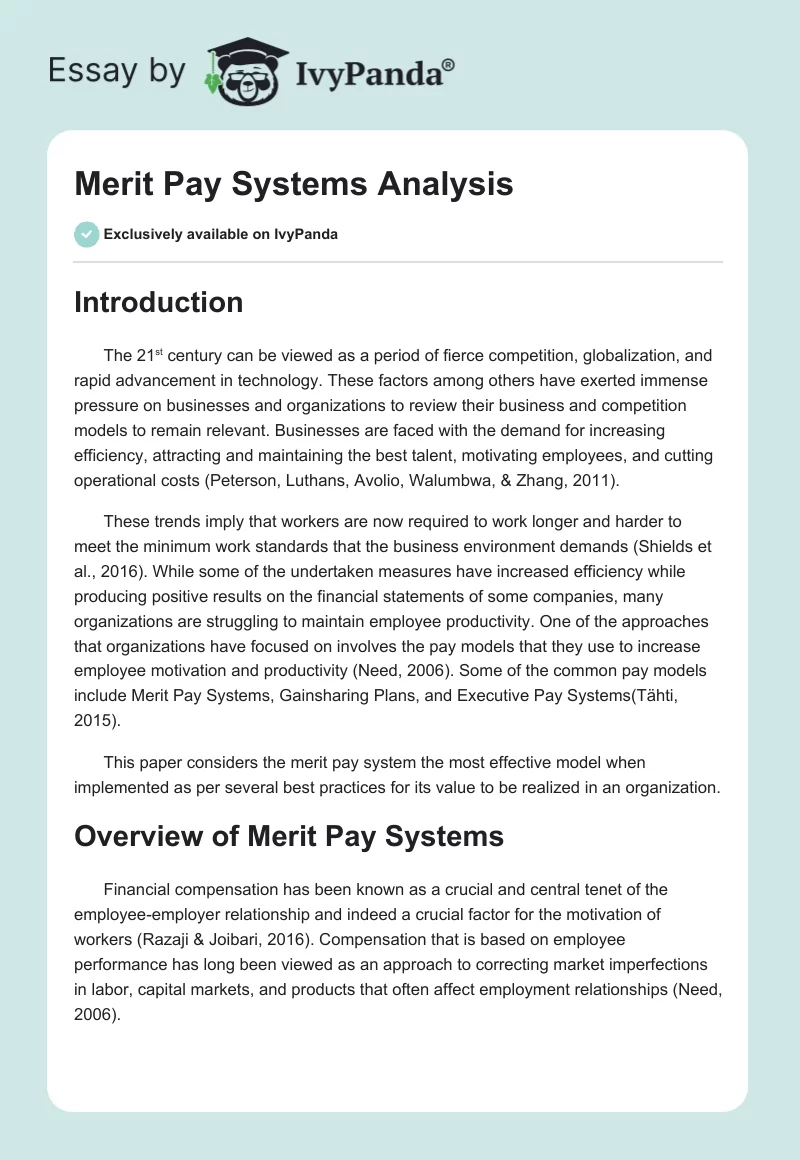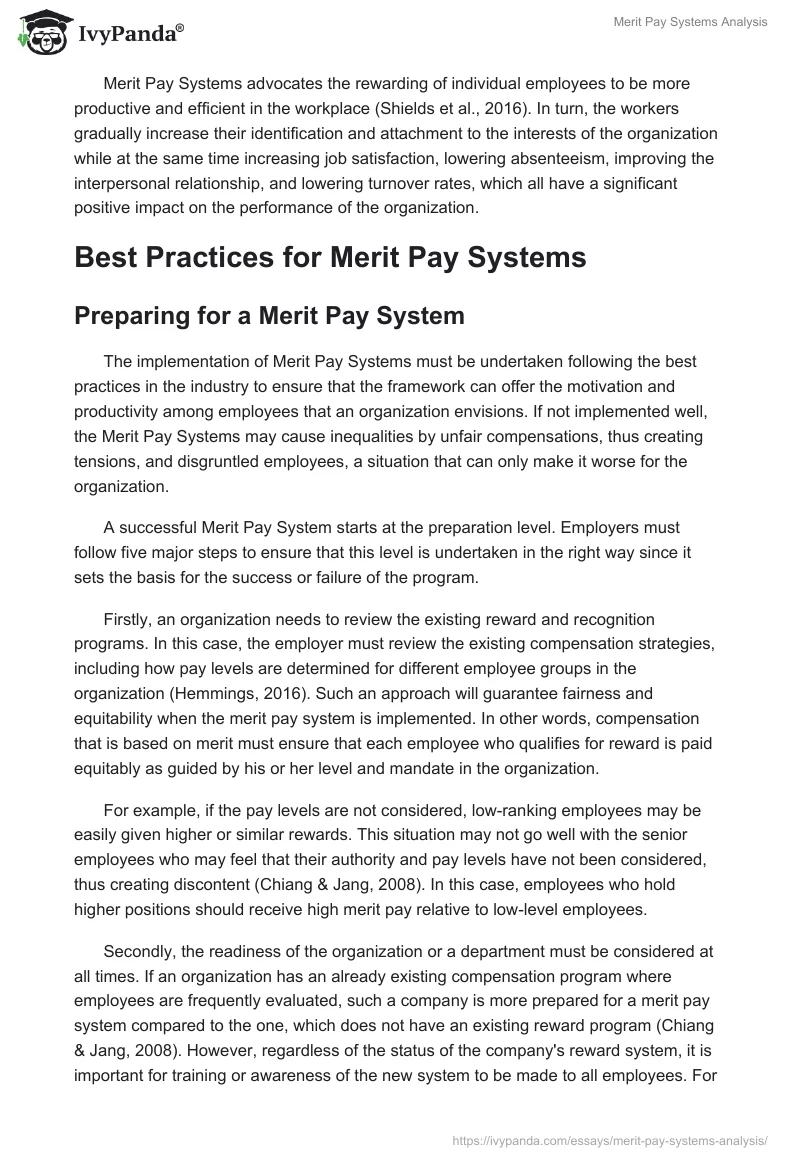Introduction
The 21st century can be viewed as a period of fierce competition, globalization, and rapid advancement in technology. These factors among others have exerted immense pressure on businesses and organizations to review their business and competition models to remain relevant. Businesses are faced with the demand for increasing efficiency, attracting and maintaining the best talent, motivating employees, and cutting operational costs (Peterson, Luthans, Avolio, Walumbwa, & Zhang, 2011).
These trends imply that workers are now required to work longer and harder to meet the minimum work standards that the business environment demands (Shields et al., 2016). While some of the undertaken measures have increased efficiency while producing positive results on the financial statements of some companies, many organizations are struggling to maintain employee productivity. One of the approaches that organizations have focused on involves the pay models that they use to increase employee motivation and productivity (Need, 2006). Some of the common pay models include Merit Pay Systems, Gainsharing Plans, and Executive Pay Systems(Tähti, 2015).
This paper considers the merit pay system the most effective model when implemented as per several best practices for its value to be realized in an organization.
Overview of Merit Pay Systems
Financial compensation has been known as a crucial and central tenet of the employee-employer relationship and indeed a crucial factor for the motivation of workers (Razaji & Joibari, 2016). Compensation that is based on employee performance has long been viewed as an approach to correcting market imperfections in labor, capital markets, and products that often affect employment relationships (Need, 2006).
Merit Pay Systems advocates the rewarding of individual employees to be more productive and efficient in the workplace (Shields et al., 2016). In turn, the workers gradually increase their identification and attachment to the interests of the organization while at the same time increasing job satisfaction, lowering absenteeism, improving the interpersonal relationship, and lowering turnover rates, which all have a significant positive impact on the performance of the organization.
Best Practices for Merit Pay Systems
Preparing for a Merit Pay System
The implementation of Merit Pay Systems must be undertaken following the best practices in the industry to ensure that the framework can offer the motivation and productivity among employees that an organization envisions. If not implemented well, the Merit Pay Systems may cause inequalities by unfair compensations, thus creating tensions, and disgruntled employees, a situation that can only make it worse for the organization.
A successful Merit Pay System starts at the preparation level. Employers must follow five major steps to ensure that this level is undertaken in the right way since it sets the basis for the success or failure of the program.
Firstly, an organization needs to review the existing reward and recognition programs. In this case, the employer must review the existing compensation strategies, including how pay levels are determined for different employee groups in the organization (Hemmings, 2016). Such an approach will guarantee fairness and equitability when the merit pay system is implemented. In other words, compensation that is based on merit must ensure that each employee who qualifies for reward is paid equitably as guided by his or her level and mandate in the organization.
For example, if the pay levels are not considered, low-ranking employees may be easily given higher or similar rewards. This situation may not go well with the senior employees who may feel that their authority and pay levels have not been considered, thus creating discontent (Chiang & Jang, 2008). In this case, employees who hold higher positions should receive high merit pay relative to low-level employees.
Secondly, the readiness of the organization or a department must be considered at all times. If an organization has an already existing compensation program where employees are frequently evaluated, such a company is more prepared for a merit pay system compared to the one, which does not have an existing reward program (Chiang & Jang, 2008). However, regardless of the status of the company’s reward system, it is important for training or awareness of the new system to be made to all employees. For example, the system must be made as public (to all employees) as possible regarding its implementation, as well as the criteria for consideration of rewards (Khan, Farooq, & Ullah, 2010).
Design of the Merit May System
Designing a merit pay follows five key steps and best practices. Firstly, an organization needs to determine the goals of the program (Nohria, Groysberg, & Lee, 2008). In this case, the company must be very clear about what it seeks to accomplish with its merit pay system. Some of the goals may include, but not limited to, attracting and retaining talent, recognizing and rewarding performance, and motivating individuals to perform better among others.
The selection of a model of merit pay system is the next important step for the successful implementation of the program. An organization can choose between reward performance and position pay models. The second model (position pay) is highly preferable in an organization. The other important step is the determination of the details of the model (Chiang & Jang, 2008). In this step, the timing and alignment with the strategy of compensation, its size and spread, and eligibility are key factors of consideration (Hemmings, 2016).
For example, the details of the model’s size and spread and eligibility are crucial since they set the basis and a determination of those who deserve rewards, thus further eliminating conflicts by ensuring that the compensation criteria are known to all. The fourth step is the determination of the administrative roles and processes towards the success of the merit system. This step involves considering the legal requirements of the system and the implementation review structures among others (Hemmings, 2016). Lastly, the organization must continually seek feedback and approval of the merit pay system from the employees or those who it will affect.
The Implementation of the Merit Pay System
The implementation of the program must follow various best practices to ensure that it supports the respective organization’s goal of increased efficiency and high productivity among employees (Shields et al., 2016). Firstly, the organization needs to assign responsibilities and duties to individuals such as heads of departments to support the implementation of the program in their relevant areas of management (Durant, Kramer, Perry, Mesch, & Paarlberg, 2006).
Secondly, it is critical to come up with the implementation processes and documentation, including policies and the underlying procedures. The next step is the training of employees, supervisors, and managers on the system to ensure their clarity and transparency (Razaji & Joibari, 2016). Lastly, communication must always be undertaken openly to ensure that all stakeholders are aware of the program.
The Merit Pay System and Christian Business Values
The merit pay model meets Christian values of fairness where all employees will have the necessary information about the program, thus eliminating the unfair disadvantage that arises when only a few individuals know about the program (Nohria et al., 2008). If the system is implemented secretly or without transparency, it can easily be interpreted as a favoritism tool that is contrary to Christian values, thus leaving employees who do not receive the rewards unhappily and unmotivated.
Thirdly, it is important to have a timeline and work plan for the implementation of the program. A small team should be put in place where necessary to oversee the implementation of the merit pay system to ensure that the process is well coordinated and that all factors are considered. Lastly, as mentioned above, the organization and the implementation must ensure that the initiative is communicated throughout and thoroughly (Hemmings, 2016). Communication is an important Christian business principle that ensures that all people are aware of a program, thus giving them a fair opportunity of utilizing or accruing its benefits. Moreover, Christian business principles support the model’s adherence to local, national, and international policies and legal frameworks (Razaji & Joibari, 2016).
Conclusion
The implementation of the merit pay system is an important step towards supporting high performance among employees and thus the competitiveness of the business in the modern environment. If an organization adheres to the discussed best practices for implementing the system, it will create a highly motivated workforce, which can support its desire to remain competitive.
Reference List
Chiang, C. F., & Jang, S. S. (2008). An expectancy theory model for hotel employee motivation. International Journal of Hospitality Management, 27(2), 313-322.
Durant, R. F., Kramer, R., Perry, J. L., Mesch, D., & Paarlberg, L. (2006). Motivating employees in a new governance era: The performance paradigm revisited. Public Administration Review, 66(4), 505-514.
Hemmings, P. (2016). Compensation Systems, Job Performance, and How to Ask for a Pay Raise. Bloomington, Indiana: Xlibris Corporation.
Khan, K. U., Farooq, S. U., & Ullah, M. I. (2010). The relationship between rewards and employee motivation in commercial banks of Pakistan. Research Journal of International Studies, 14(1), 37-52.
Need, W. (2006). Human resource Management: Gaining a competitive advantage. New York, NY: Oxford University Press.
Nohria, N., Groysberg, B., & Lee, L. E. (2008). Employee motivation. Harvard Business Review, 86(8), 78-84.
Peterson, S. J., Luthans, F., Avolio, B. J., Walumbwa, F. O., & Zhang, Z. (2011). Psychological capital and employee performance: A latent growth modeling approach. Personnel Psychology, 64(2), 427-450.
Razaji, A. C., & Joibari, A. (2016). The Relationship of Reward System with Staff Motivation to Participate in Target Setting. International Journal of Humanities and Cultural Studies, 1(1), 25-36.
Shields, J., Brown, M., Kaine, S., Dolle-Samuel, C., North-Samardzic, A., McLean, P.,… & Plimmer, G. (2016). Managing Employee Performance & Reward: Concepts, Practices, Strategies. Cambridge, England: Cambridge University Press.
Tähti, S. (2015). Employee segmentation and motivation. New York, NY: Sage Publishers.


